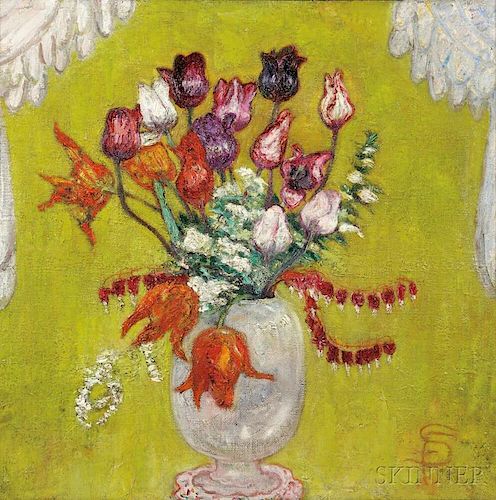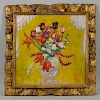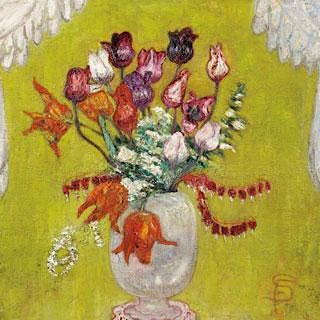Florine Stettheimer (American, 1871-1944) Floral Still Life
Lot 355
About Seller
Bonhams Skinner
274 Cedar Hill Street
Marlborough, MA 01752
United States
Founded over four decades ago, Bonhams Skinner offers more than 60 auctions annually. Bonhams Skinner auctions reach an international audience and showcase the unique, rare, and beautiful in dozens of categories, including the fine and decorative arts, jewelry, modern design, musical instruments, sc...Read more
Categories
Estimate:
$75,000 - $100,000
Absentee vs Live bid
Two ways to bid:
- Leave a max absentee bid and the platform will bid on your behalf up to your maximum bid during the live auction.
- Bid live during the auction and your bids will be submitted real-time to the auctioneer.
Bid Increments
| Price | Bid Increment |
|---|---|
| $0 | $10 |
| $100 | $25 |
| $500 | $50 |
| $1,000 | $100 |
| $3,000 | $250 |
| $5,000 | $500 |
| $10,000 | $1,000 |
| $30,000 | $2,500 |
| $50,000 | $5,000 |
| $100,000 | $10,000 |
| $300,000 | $25,000 |
| $500,000 | $50,000 |
| $1,000,000 | $100,000 |
About Auction
By Bonhams Skinner
Jan 22, 2016 - Jan 23, 2016
Set Reminder
2016-01-22 16:00:00
2016-01-23 16:00:00
America/New_York
Bidsquare
Bidsquare : Fine Paintings & Sculpture
https://www.bidsquare.com/auctions/skinner/fine-paintings-sculpture-1196
Bonhams Skinner bidsquare@bonhamsskinner.com
Bonhams Skinner bidsquare@bonhamsskinner.com
- Lot Description
Florine Stettheimer (American, 1871-1944)
Floral Still Life
Monogrammed "FS" l.r., identified on labels from Richard L. Feigen & Co., New York, and the Museum of Art, Rhode Island School of Design, Providence, affixed to the frame backing.
Oil on canvas, 25 3/8 x 25 3/8 in. (64.5 x 64.5 cm), framed.
Condition: Lined, new stretcher, retouch, scattered areas of craquelure.
Provenance: A Rhode Island estate.
Exhibitions: 1900 to Now, Modern Art from Rhode Island Collections, Museum of Art, Rhode Island School of Design, Providence, Rhode Island, January 22-May 1, 1988, illustrated p. 63 of exhibition catalog.
N.B. Florine Stettheimer is an artist's artist, a painter, designer, and poet. Born in Rochester, New York, into a wealthy, intellectual German banking family, Florine spent her childhood in Europe. She studied at the Art Students League of New York from 1892 to 1895, then returned to Europe where she lived with her mother, Rosetta, and two sisters (Caroline and Henrietta) until the outbreak of World War I in 1914.
Financially independent, Florine Stettheimer did not need to sell her works. While she exhibited periodically at the Society of Independent Artists and the Whitney, she had only one one-woman show during her lifetime. This was held in 1916 at Knoedler & Co., and featured high-keyed works inspired by Matisse. None of the twelve works in the show sold, and she chose not to go this route again. She had no taste for publicity, and did not relish participating in exhibitions. Instead, she showed her paintings primarily through the salons that she and her sisters, known as "The Stetties," held in their apartment on West 58th Street in New York. Their lifestyle became legendary, with Florine painting, Carrie decorating an enormous dollhouse (now in the Museum of the City of New York), and Ettie writing fiction. Their salons brought together an elite intellectual circle of artists, poets, and actors of the day, including Marcel Duchamp (of whom Florine painted several portraits), Zorach, Archipenko, Picabia, Lachaise, and O'Keeffe, art critic Henry McBride.
Florine Stettheimer had wide ranging interest in art from many periods including Japanese prints, Persian miniatures, and early Renaissance paintings, which share an emphasis on decorative schemes of color, pattern, and rhythm. She used bold color, faux-naïve style, and inventive compositions as she developed her highly personalized, mature style. In 1917 she painted Sunday Afternoon in the Country, a pivotal work now in the collection of The Cleveland Museum of Art. The scene depicts a weekend picnic at the family's country home on the Hudson River and is typical of the narrative aspects of her work. The artist shows herself in the upper right, working at her easel, while in the foreground at lower left photographer Edward Steichen is photographing Marcel Duchamp, with Florine's sister Ettie standing behind him with her arms outstretched.
Florine Stettheimer did not feel restricted by the boundaries of two-dimensional art. In 1934 she designed avant-garde costumes and sets for the opera Four Saints in Three Acts, with a libretto by Gertrude Stein and music by Virgil Thomson, perhaps finding inspiration from time spent in Paris (1912) where she experienced the excitement of Diaghilev's Ballets Russes. She also wrote poetry that some have compared to Emily Dickinson, with their richly imaged inner solitude.
After her mother died in 1935, the Stettheimer household broke up. Florine lived alone at her studio and home at 8 West 40th Street and devoted herself to her art. Among other important work, she completed the series of four paintings known as the Cathedrals series, now at the Metropolitan Museum of Art: Cathedrals of Broadway (1929), Cathedrals of Fifth Avenue (1931), Cathedrals of Wall Street (1939), and Cathedrals of Art (1942-44).
At the time of her death in 1944, most of Florine Stettheimer's paintings were still in the possession of her family. Ettie Stettheimer donated works to many museums, and two years after her death, a large retrospective was held at the Museum of Modern Art.
Estimate $75,000-100,000
Horizontal line of retouch at c.l. edge measuring 3 1/3 inches across and located 12 1/2 inches up from the l.l. corner; a second horizontal line of retouch 1 1/4 inches across, located 4 inches up from the l.l. corner; a few small dots of retouch to the l.l. corner; an area of possible retouch at upper center edge, just inside of the edge of the curtain on the right, about 1 inch high and 2 inches across; craquelure is fine and stable; canvas has been stretched on a new stretcher, with metal edging around the outside perimeter of the stretched canvas. The lining is probably adhered with BEVA.
The absence of a condition statement does not imply that the lot is in perfect condition or completely free from wear and tear, imperfections or the effects of aging. Condition requests can be obtained via email (lot inquiry button) or by telephone to the appropriate gallery location (Boston/617.350.5400 or Marlborough/508.970.3000). Any condition statement given, as a courtesy to a client, is only an opinion and should not be treated as a statement of fact. Skinner Inc. shall have no responsibility for any error or omission. - Shipping Info
-
Please visit http://www.skinnerinc.com/services/payment-and-shipping/ for information regarding the collection of items purchased at auction.
-
- Buyer's Premium



 EUR
EUR CAD
CAD AUD
AUD GBP
GBP MXN
MXN HKD
HKD CNY
CNY MYR
MYR SEK
SEK SGD
SGD CHF
CHF THB
THB





































